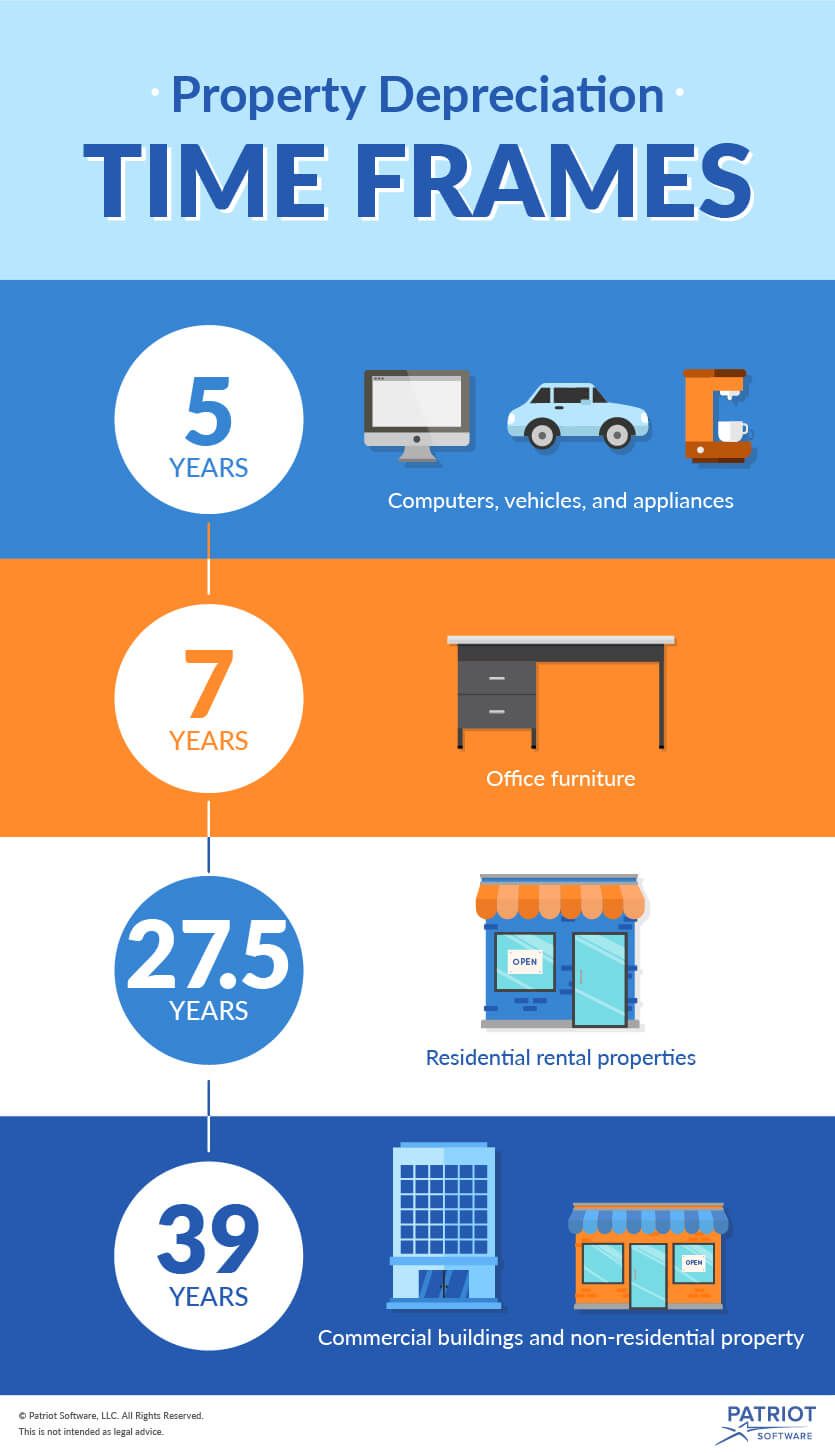As a small business owner, you need equipment to run your company. Whether it’s a machine or vehicle, costs can add up fast. Did you know you can get major tax breaks for business property expenses? You can lower your tax burden with depreciation. Find out how to calculate depreciation expense for your small business.
What is depreciation?
If you use an asset for over a year, it often loses value. To offset the asset’s declining value with its cost, you can depreciate the expense. Depreciation reduces the value of an asset over time.
Depreciation is an income tax deduction. By decreasing the value of the asset, your overall taxable income lowers. As your taxable income lowers, your tax liability decreases.
To depreciate property, you do not claim the entire cost of the asset on your tax return. Instead, you spread the cost out over several years.
Depreciation is considered an expense in your accounting books. List depreciation on the income statement. Depreciation is a noncash expense, so it does not affect cash flow or the amount of cash you have on hand.
What can I depreciate?
You can depreciate tangible, long-term property that you use for business operations. The property must be a physical object that you can see and touch. And, the property must last more than one year at your business. Usually, you must own the property to depreciate it.
Common assets you might depreciate include vehicles, furniture, equipment, and buildings.
You cannot depreciate some assets. You can’t depreciate land because it does not wear out and lose value. You also cannot depreciate inventory since you sell it for revenue. Usually, you cannot depreciate leased property.
How do I depreciate property?
Take a depreciation deduction on your tax return by attaching Form 4562, Depreciation and Amortization, to your tax return.
Different kinds of property can be depreciated for a certain number of years. To find out how long you can depreciate assets, review the IRS’s Publication 946, How to Depreciate Property.
Here are some common time frames for depreciating property:
- Computers, office equipment, vehicles, and appliances: For five years
- Office furniture: For seven years
- Residential rental properties: For 27.5 years
- Commercial buildings and nonresidential property: For 39 years

You need some key information about the property. You must know the property’s initial cost. And, you need to determine how many years the asset will hold value at your business.
How to calculate depreciation expense
There is no single depreciation expense formula. In fact, there are several methods of calculating depreciation.
There are three common methods for depreciation:
- Straight-line depreciation
- Accelerated depreciation
- Section 179
Straight-line depreciation
Straight-line depreciation is the easiest method for depreciating property. With this method, you spread the cost evenly across the asset’s expected lifespan.
For example, you buy business equipment worth $4,000. You expect the equipment to hold value for four years.
Using the straight-line method, spread the expense out equally over the equipment’s lifespan. The depreciation expense is $1,000 per year for four years ($4,000 / 4 years = $1,000 per year)
| Year Equipment is Used | Expense |
|---|---|
| Year 1 | $1,000 |
| Year 2 | $1,000 |
| Year 3 | $1,000 |
| Year 4 | $1,000 |
| Total | $4,000 |
Accelerated depreciation
With accelerated depreciation, you can expense items faster than the straight-line method. You deduct a higher percentage of the property’s total cost during the first few years after purchasing. Then, take smaller deductions in later years.
For example, you buy a vehicle for your business for $10,000. Using the accelerated method, you deduct $4,000 in the first year. For every year after, the amount you deduct becomes smaller.
| Year Equipment is Used | Expense |
|---|---|
| Year 1 | $4,000 |
| Year 2 | $3,000 |
| Year 3 | $2,000 |
| Year 4 | $1,000 |
| Total | $10,000 |
Use IRS documents to figure out deduction amount using the accelerated method. Take a look at the IRS’s Modified Accelerated Cost Recovery System (MACRS). Also, check out the percentage table guide in Publication 946, Appendix A for the percentage you can deduct each year.
Section 179
As a small business owner, you can deduct the total cost of an asset in the same year you bought it with Section 179.
You can use Section 179 for both new and used equipment. Section 179 is available for most types of assets, including general business equipment and off-the-shelf software.
To claim Section 179, you must use the property more than 50% of the time during regular business operations.
There are limits to Section 179:
- You can deduct up to $500,000 each year.
- You can spend up to $2,000,000 on depreciable property.
If you spend over $2,000,000, reduce your Section 179 deduction for each extra dollar. In other words, if you spend more than $2,000,000, you can’t deduct the full expense with Section 179.
You also cannot use Section 179 to deduct more in one year than your net taxable business income.
Bonus depreciation and Section 179
In some cases, you can use bonus depreciation if you spend more than the Section 179 limit. Bonus depreciation is worth 50% of expenses over the $2,000,000 limit for the 2016 tax year.
So, if you spent $2,500,000 on assets, you went $500,000 over the Section 179 spending limit. You can use bonus depreciation on the extra $500,000. Depreciate 50% of the extra amount, or $250,000.
The percentage you can deduct with bonus depreciation changes each year. The following amounts are the percentages you can deduct in future tax years:
| Year | Deduction |
|---|---|
| 2016 | 50% |
| 2017 | 50% |
| 2018 | 40% |
| 2019 | 30% |
Claim bonus depreciation in the first year you buy an asset. Bonus depreciation only covers new equipment. You cannot use bonus depreciation on leased property. And, you cannot claim bonus depreciation on property where you use alternative depreciation schedules.
Book value vs. market value of asset
When you use depreciation, you need to adjust your accounting books. As you add a depreciation expense journal entry, you must decrease the initial value of the asset.
For example, you buy equipment for $5,000. The initial value of the equipment is $5,000.
You decide to depreciate the expense over five years. Using the straight-line method, distribute the cost equally over the equipment’s lifespan. Expense $1,000 in depreciation each year for five years ($5,000 / 5 years = $1,000 per year).
Each year you depreciate, subtract the expensed amount from the value of the equipment.
| Year | Value of Asset | Depreciation Expense |
|---|---|---|
| Year 1 | $4,000 | $1,000 |
| Year 2 | $3,000 | $1,000 |
| Year 3 | $2,000 | $1,000 |
| Year 4 | $1,000 | $1,000 |
| Year 5 | $0 | $1,000 |
As the value of the asset decreases, its worth is called the book value. When the asset no longer has book value, it is fully depreciated. (In the example above, the asset’s book value is $0 in Year 5. The asset is fully depreciated in Year 5).
The book value of property will likely be higher or lower than its actual market value. The market value is the amount you can sell the property for.
If you sell the asset before it is fully depreciated, you need to adjust your books. You will adjust the sale amount of the asset to its book value. To make the adjustment, take a capital gain or loss.
Let’s say you sell the equipment in the example above during Year 6. At Year 6, the equipment is fully depreciated, and its book value is $0.
You sell the equipment for $1,000. By selling the asset, you earn a capital gain. In your books, record a capital gain of $1,000.
Need an easy way to keep track of your small business’s transactions? Patriot’s online accounting software uses a cash-in, cash-out system so you can complete your books in a few simple steps. We offer free, U.S.-based support. Try it for free today.
